Keating Hot Plate Gas Owner's manual
- Category
- Cookers
- Type
- Owner's manual
This manual is also suitable for

Record the Serial number and Model number of this Gas Hot Plate in the spaces
provided. Keep these numbers for future reference.
GAS HOT PLATE
MG-2/MG-4
KEEP A COPY OF YOUR BILL OF SALE.
The date on the bill establishes the warranty period should service be required.
If service is performed, it is in your interest to obtain and keep all receipts.
Keating commercial Hot Plates are not intended for household use.
As continuous product improvement occurs, specifi cations may be
changed without notice.
IMPORTANT:
THE USER'S MANUAL PROVIDES SPECIFIC OPERATING INSTRUCTIONS
FOR YOUR MODEL. USE THE GAS HOT PLATE ONLY AS INSTRUCTED IN
THIS MANUAL.
Part # 037429
gasHotPlate_2013
02/18
1-800-KEATING | keatingofchicago.com
MANUAL
KEEP THIS MANUAL FOR TRAINING NEW PERSONNEL.
SERIAL NUMBER
MODEL NUMBER

PROPANE GAS MAY EVENTUALLY LOSE ITS ODOR AND PRECAUTIONS SHOULD BE
TAKEN TO ASSURE THAT PROPANE GAS IS NOT PRESENT EVEN THOUGH YOU DO NOT
DETECT AN ODOR. IF THERE IS ANY DOUBT, YOU SHOULD CALL YOUR LOCAL PRO-
PANE GAS SUPPLIER FOR ASSISTANCE.
PURCHASER SHOULD POST IN A PROMINENT LOCATION INSTRUCTIONS TO BE FOLLOWED
IN THE EVENT THE USER SMELLS GAS. THIS INFORMATION SHALL BE OBTAINED BY CON-
SULTING THE LOCAL GAS SUPPLIER.
WARNING
Improper installation
can cause damage,
injury or death.
ShockBurnsGas
WARNING
Do not store
flammable liquids
near this or
any other appliance.
IF NOT INSTALLED, OPERATED AND MAINTAINED IN ACCORDANCE WITH THE MANU-
FACTURER’S INSTRUCTIONS, THIS PRODUCT COULD EXPOSE YOU TO SUBSTANCES
IN FUEL OR IN FUEL COMBUSTION WHICH CAN CAUSE DEATH OR SERIOUS ILLNESS
AND WHICH ARE KNOWN TO THE STATE OF CALIFORNIA TO CAUSE CANCER, BIRTH
DEFECTS OR OTHER REPRODUCTIVE HARM.
9902091 9902091
i
Improper installation, adjustment, alteration, service or maintenance can
cause property damage, injury or death. Read the installation, operating
and maintenance instructions thoroughly before installing or servicing this
equipment.
Do not store or use gasoline or other fl ammable vapors or liquids in the
vicinity of this or any other appliance.
FOR YOUR SAFETY:

1-800-KEATING |
GAS HOT PLATE
Important Safety Instructions ............................................ i
INTRODUCTION .............................................................. 1
INSTALLATION
Damage During Shipment ................................................ 1
Options .......................................................................... 2
Standard Features ........................................................... 2
Ratings ........................................................................... 2
Options .......................................................................... 2
Safety Precautions ..................................................... 2 - 3
FIRST STEPS
National Code Requirement ............................................. 3
Positioning ...................................................................... 3
Restraining Devices ......................................................... 3
Gas Connection .............................................................. 4
Electrical Connection ....................................................... 4
Gas Leak Testing ............................................................. 4
PLACING YOUR KEATING HOT PLATE IN OPERATION
Lighting ..................................................................... 4 - 5
Shutdown ....................................................................... 5
Cleaning ......................................................................... 5
PREVENTATIVE MAINTENANCE
Warranty Repairs ............................................................ 5
Preventive Maintenance Chart ......................................... 5
SERVICE DIAGNOSIS
Troubleshooting ............................................................... 6
ORDERING PARTS .......................................................... 6
Warning and Operating Plates............................................ 6
Parts List ................................................................... 7 - 8
Hot Plate Assembly ......................................................... 8
Wiring Diagram ................................................................ 9
Warranty Information ..................................................... 10
TABLE OF CONTENTS
INTRODUCTION
1
Instructions in this manual should be read thoroughly before attempting to operate the Keating Gas Hot Plate.
All installation and service on Keating equipment must be performed by qualifi ed, certifi ed, licensed and/or
authorized installation or service personnel.
Operating information for Keating equipment has been prepared for use by qualifi ed and/or
authorized personnel.
Keating equipment is made in the USA and has American sizes of hardware. All metric conversions
are approximate.
INSTALLATION INSTRUCTIONS
Proper installation will assure top performance.
Alterations of any kind to your equipment will void the
warranty. Before uncrating, check equipment carefully
for damage.
IF EQUIPMENT ARRIVES DAMAGED
Keating does not assume responsibility for loss or
damage incurred in transit.
IMPORTANT
This merchandise has been thoroughly inspected
and carefully packed before leaving our plant.
Responsibility for its safe delivery was assumed by
the carrier at the time of shipment. Claims for loss or
damage to the contents should, therefore, be made
upon the carrier, as follows:
CONCEALED LOSS OR DAMAGE
Concealed loss or damage means loss or damage
which does not become apparent until the mer-
chandise has been unpacked. The contents may be
damaged in transit due to rough handling even though
the carton may not show external damage. When the
damage is discovered upon unpacking, make a writ-
ten request for inspection by the carrier’s agent within
fi fteen days of the delivery date. Then fi le a claim with
the carrier since such damage is the carrier’s respon-
sibility. By following these instructions carefully, we
guarantee our full support of your claims to protect
you against loss from concealed damage.
VISIBLE LOSS OR DAMAGE
Any external evidence of loss or damage must be
noted on the freight bill or express receipt, and
signed by the carrier’s agent. Failure to adequately de-
scribe such external evidence of loss or damage may
result in the carrier refusing to honor a damage claim.
The form required to fi le such a claim will be supplied
by the carrier.
DO NOT RETURN DAMAGED MERCHANDISE TO
KEATING. FILE YOUR CLAIM AS STATED ABOVE.

| keatingofchicago.com
2
Keating MG-2 and MG-4 Hot Plates are designed to
give maximum production effi ciency, delivering high
quality food products. The following design features
are incorporated in all Keating Hot Plates.
STANDARD FEATURES
• Highly polished stainless steel front
• Infinite controls
• 12" working height
• Gas and air adjustments
• Easy access for servicing
• 3/4" gas connection
• 100% factory testing
RATINGS
• 15,000 BTU/hr. input per burner (natural gas and
Propane)
• 4" WC (natural gas) or 10" WC (Propane) burner
gas pressure
• 49 (natural gas) or 53 (Propane) burner orifice size
• 3/4" gas supply pipe recommended
OPTIONS
• Natural Gas or Propane
• Spark Ignition System
MODEL VARIATIONS
MG-2 Model: The MG-2 model has two burners
MG-4 Model: The MG-4 model has four burners
SAFETY PRECAUTIONS
THIS SYMBOL WARNS YOU THAT SERIOUS BURNS
OR OTHER INJURIES MAY RESULT IF SAFETY IN-
STRUCTIONS ARE NOT FOLLOWED.
• This service manual should be retained in a safe
place for future reference. The installation of your
new hot plate must conform to local codes or in
the absence of local codes, with the current
National Fuel Gas Code ANSI Z223.1/NFPA 54
(latest edition), Natural Gas Installation Code
CAN/CGA-B149.1 or Propane Installation Code
CAN/CGA-B149.2.
• Your ventilation hood, when installed, must
conform to the current ANSI/NFPA 96 standard
(latest edition).
• No frame or restriction shall be constructed
around the hot plate that will restrict air
movement into the hot plate’s combustion area
or prevent proper ventilation.
• Keating hot plates are designed to operate on
the gas fuel specified on the serial plate and
must not be operated with another gas fuel.
They cannot be converted to another gas fuel by
turning or engaging a switch.
DO NOT STORE OR USE GASOLINE OR OTHER FLAM-
MABLE VAPORS AND LIQUIDS IN THE VICINITY OF
THIS OR ANY APPLIANCE.
You will post, in a prominent location, instructions to
be followed in the event the user smells gas. This
information shall be obtained from your local gas
supplier.
IMPORTANT: IN THE EVENT A GAS ODOR IS DE-
TECTED, SHUT DOWN UNIT AT MAIN SHUT-OFF
VALVE AND CONTACT THE LOCAL GAS COMPANY
OR GAS SUPPLIER FOR EMERGENCY SERVICE.
• Suitable for installation on combustible
surfaces.
• You must maintain this appliance free and clear
from combustibles.
• You must maintain the following minimum
clearances from combustible and
non-combustible construction:
MINIMUM CLEARANCE
CONSTRUCTION CLEARANCES
COMBUSTIBLE NON-COMBUSTIBLE
BACK 6" 0"
RIGHT SIDE 6" 0"
LEFT SIDE 6" 0"
• You must install this appliance at least 16
inches away from any open flame.
• Adequate clearance for servicing and proper
operation must be maintained. Your hot plate is
designed to be serviced from the front.
• Keating commercial hot plates are not intended
for household use.
• ALWAYS instruct new employees on proper hot
plate operation.
• A hot plate should be operated ONLY by properly
trained personnel.
• ALWAYS turn hot plate off each night.
• ALWAYS disconnect fuel source before servicing.
• NEVER leave a hot plate unattended during
operation.

1-800-KEATING |
GAS HOT PLATE
3
• NEVER introduce objects into hot plate, while
operational, which are not designed or made for
cooking.
• THIS HOT PLATE MAY NOT BE ALTERED, MODIFIED
OR CHANGED IN ANY WAY.
The State of California enacted the California Safe
drinking water and Toxic Enforcement Act of 1986,
(Prop. 65), which “prohibits any person in the course
of doing business from knowingly and intentionally ex-
posing any individual to a chemical known to the State
of California to cause cancer or reproductive toxicity
without first giving clear and reasonable warning to
such individuals.” The Governor’s Scientific Advisory
Panel added carbon monoxide to the list of hazardous
chemicals known to cause reproductive harm.
Carbon monoxide would not be present in
concentrations that would pose a “significant risk” to
the consumer when the equipment is installed, oper-
ated and maintained as follows:
• Installed under a properly designed operating
exhaust hood.
• Connected to the type of gas for which the
appliance is manufactured.
• Pressure regulator is installed in the appliance
and adjusted for the manifold pressure marked
on the serial plate.
• Adequate air supply to the appliance.
• In-line pressure regulator, not supplied by Keating,
must be installed outside the appliance.
• The equipment is operated in the manner intended
using the proper utensils.
• Keep the equipment clean and have it checked
periodically.
• Burner air adjustments, mechanical maintenance
and repairs must be performed by qualified service
personnel.
If the equipment is not installed, operated and main-
tained in accordance with the above, concentrations of
carbon monoxide in excess of the established limits
could be present in the kitchen environment.
ALL PERSONNEL IN THE WORK PLACE WHO MAY BE
SUBJECT TO ANY EXPOSURE OF CARBON MONOXIDE
MUST BE WARNED OF SUCH POSSIBLE EXPOSURE.
THIS WARNING SHOULD BE CONVEYED IN A MANNER
SO THAT IT IS CLEARLY UNDERSTOOD BY THE
EMPLOYEE, AND THE EMPLOYEE SHOULD BE ASKED
IF IN FACT HE OR SHE UNDERSTANDS THE CORRECT
METHOD OF OPERATION OF THE EQUIPMENT AND
THAT A RISK OF EXPOSURE EXISTS IF THE EQUIPMENT
IS OPERATED IMPROPERLY.
IF NOT INSTALLED, OPERATED AND MAINTAINED IN
ACCORDANCE WITH THE MANUFACTURER’S IN-
STRUCTIONS, THIS PRODUCT COULD EXPOSE YOU
TO SUBSTANCES IN FUEL OR IN FUEL COMBUSTION
WHICH CAN CAUSE DEATH OR SERIOUS ILLNESS
AND WHICH ARE KNOWN TO THE STATE OF CALIFOR-
NIA TO CAUSE CANCER, BIRTH DEFECTS OR OTHER
REPRODUCTIVE HARM.
FIRST STEPS
NATIONAL CODE REQUIREMENT
The installation must conform with local codes, or in
the absence of local codes, with the National Fuel
Gas code, ANSI Z223.1 or the Natural gas Installation
Code, CAN/CGA-B149.1 or the Propane Installation
Code, CAN/CGA-B149.2. Flexible connectors must
comply to ANSI Z221.69/CAN/CGA1.16.
When pressure testing at test pressures less than or
equal to 1/2 psig (3.45 KPA), hot plate must be iso-
lated from gas supply piping. When pressure testing
at test pressures above 1/2 psig (3.45 KPA), hot plate
must be disconnected from gas supply piping system.
POSITIONING
The hot plate must be no closer than 6" from any com-
bustible material and 16" away from any open fl ame.
The hot plate must be placed under an exhaust hood
with a fi re retardant system. Your ventilation hood,
when installed, must conform to the current ANSI/
NFPA 96 standard. ALL connections and placement
must comply with local and national codes. It is the
responsibility of the owner and local installer to comply
with these regulations when installing the hot plate.
RESTRAINING DEVICES
Hot plates must be restrained to
prevent tipping when installed in
order to avoid splashing, spilling,
etc. of hot liquid. The restraining
method may be a manner of in-
stallation or by separate means.
Adequate means must also be
provided to limit the movement of
the appliance without depending on
the connector, the quick-disconnect
devise or its associated piping to limit the appliance
movement.
Connectors must comply with the current ANSI
Z21.69/CAN 1 6.10-88 standard for connectors for
movable gas appliances. Quick-disconnect devices
must comply with the current ANSI Z21.41/CAN 1 6.9-
M79 standard for quick-disconnect devices meet these
standards.
NOTICE
Restraining devices
required.

| keatingofchicago.com
4
GAS CONNECTION
• PIPE JOINT COMPOUNDS RESISTANT TO PROPANE
GASES MUST BE USED.
• BEFORE OPERATING THIS HOT PLATE, CHECK
PIPE JOINTS FOR LEAKS BY USING A SOAP AND WA-
TER SOLUTION ONLY. DO NOT USE AN OPEN FLAME!
FOR YOUR SAFETY: Do not store or use gasoline or
other fl ammable vapors and liquids in the vicinity of
this or any other appliance.
Connect the hot plate to the main gas supply line at
the rear of the hot plate. The piping should be a mini-
mum of 3/4" IPS supply pipe for a single hot plate.
A 3/4" NPT manual gas valve is shipped with each
single hot plate for fi eld installation. The required gas
pressure for proper operation of each hot plate is 4"
water column for natural gas and 10" water column
for Propane gas.
In-line pressure regulators are not supplied by
Keating. They are to be provided and installed by oth-
ers as directed by local codes.
NOTE: If more than one gas hot plate is on the same
supply line, you may require a larger line. Consult your
local gas company to assure adequate volume and
pressure. Refer to serial plate for proper gas require-
ments for your particular model.
ELECTRICAL CONNECTION
The Keating hot plate with an option-
al spark ignitor is equipped with a 6'
neoprene covered, 3 wire electrical
cord with a three-pronged grounded
plug for protection against electrical
shock. This plug must be placed into
a 120V properly grounded three-
pronged outlet. For proper grounding
procedures see local codes or, in the
absence of local codes, the current
National Electrical Code ANSI/NFPA 70 or Canadian
Electrical Code CAN 22.1 as applicable.
NOTE: For hot plates with optional spark ignitors, the
electrical wiring diagram is located on the front of the
control panel. Hot plates with constant pilots do not
require any electrical connections.
DO NOT CUT OR REMOVE THE GROUNDING PRONG
FROM THIS PLUG.
GAS LEAK TESTING
Prior to lighting your hot plate:
1. Make sure all manual gas valves and gas valves
(infi nite controls) are in the “OFF” (fully clockwise)
position.
2. Turn main ON/OFF manual gas valve to the “ON”
position.
3. Have your plumber or gas company check for
leaks with a soap solution. (NEVER check with a
match!)
4. Have your plumber or gas company representa-
tive light the constant pilot. (Not necessary if your
hot plate has an optional spark ignitor.)
PROPANE GAS MAY EVENTUALLY LOSE ITS ODOR
AND PRECAUTIONS SHOULD BE TAKEN TO ASSURE
THAT IT IS NOT PRESENT EVEN THOUGH YOU DO
NOT DETECT AN ODOR. IF THERE IS ANY DOUBT,
YOU SHOULD CALL YOUR LOCAL PROPANE GAS
SUPPLIER FOR ASSISTANCE.
OPERATING
LIGHTING
Keating hot plates are designed to provide maximum
effi ciency and deliver high quality food products.
Follow lighting procedure as listed.
OPERATION OF THIS HOT PLATE SHOULD BE LIMIT-
ED TO PERSONNEL WHO HAVE BEEN THOROUGHLY
TRAINED IN OPERATING PROCEDURES.
1. Open the manual gas valve.
2. For hot plates with constant pilots, light the con-
stant pilot (located between the front and rear burn-
ers) with a match. For hot plates with spark ignitors,
push in the red knob and rotate it fully counterclock-
wise unit the burner ignites.
For hot plates with spark ignitors, rotating the
red knob without holding it in may damage the
gas valve (infi nite switch).
WARNING
Plug into a
properly grounded
three-prong receptacle.
Figure 1
Main Gas
Connection

1-800-KEATING |
GAS HOT PLATE
If the pilot or burner fails to stay lit, wait fi ve
minutes before attempting to relight to allow any
accumulated gas to escape.
3. For hot plates with constant pilots, rotate the red
knob counter clockwise to the desired setting. For
hot plates with spark ignitors, rotate the red knob
clockwise to the desired setting after the burner
ignites.
NOTE: The left knob operates the back burner and the
right knob operates the front burner.
SHUTDOWN
1. Rotate the red knob fully clockwise for each
burner.
CLEANING
When cleaning your hot plate, use Keating Klenzer, the
fi nest dry stainless steel polish available, to restore
your hot plate’s exterior to it original luster.
For hot plates with optional spark ignitors, dis-
connect the electrical power source before doing
any cleaning.
WARRANTY REPAIRS
Keating’s warranty begins with the date of installation.
In the event that your Hot Plate, under warranty, needs
repairs other than routine maintenance or clean-
ing, you are required to contact Keating of Chicago
(at 1-800-KEATING) before calling a local service
company.
PREVENTIVE MAINTENANCE
Preventive maintenance should be done in daily,
weekly, monthly and yearly intervals as necessary.
Following preventive maintenance procedures will help
keep your hot plate working effi ciently. Proper care
and servicing will lead to years of quality performance.
PREVENTATIVE MAINTENANCE CHART
TIME FRAME OPERATOR/OWNER
AT LEAST
DAILY*
• Check controls.
• Drain and clean drip pan.
AT LEAST
WEEKLY*
• Clean hot plate
TIME FRAME QUALIFIED SERVICE PERSONNEL
AT LEAST
YEARLY*
• Disassemble hot plate to clean
burners and orifi ces.
*High production facilities should be checked more often.
Contact the factory or a local service company to perform
maintenance and repairs.
5

| keatingofchicago.com
6
SERVICE DIAGNOSIS
On constant pilot models, the pilot light will be between 3/8" to 1/2" high and burn clear blue. The constant
pilot consumes about 180 BTU/hr. of gas and is used to ignite the burners.
The following diagnosis is only to be used as a guide to qualifi ed service personnel. Keating recommends that
you use a qualifi ed & licensed service company. (Equipment still under warranty requires it.) Call 1-800-KEATING
if you need assistance in locating a qualifi ed service company.
NOTE: To correctly and quickly diagnose the system, the chart below should be followed in sequential order.
TROUBLE SHOOTING CHART
PROBLEM PROBABLE CAUSE SOLUTION
Constant pilot won’t light a. Gas isn’t turned on.
b. Clogged constant pilot orifi ce.
a. Turn gas valve on. If using fl exible
connector with quick disconnect, make
sure that the quick disconnect is
completely engaged.
b. Clean the pilot orifi ce.
Delayed ignition a. Low gas supply or pressure.
b. Low pilot fl ame height.
a. Verify size of incoming gas line to
equipment and check gas pressure.
b. Adjust pilot fl ame height. Use a
qualifi ed service company.
Flames are too high a. Gas valve (infi nite control) set too high.
b. Excessive gas supply or pressure.
c. Exhaust problems.
a. Turn valve counterclockwise to
decrease gas fl ow.
b. Check to see if an inline regulator is
present in the main gas line. Have a
qualifi ed service person adjust it and
check orifi ces to ensure proper sizes. If
an inline regulator is not present, have
one installed.
c. Contact your HVAC representative.
Flames are low or come out of burner
air shutter
a. Gas valve (infi nite control) set too low.
b. Low gas supply or pressure.
a. Turn valve clockwise to increase gas
fl ow.
b. Verify size of incoming gas line to
equipment and check gas pressure.
ORDERING PARTS
Parts may be ordered by calling 1-800-KEATING or your local Keating service company. We recommend using
genuine Keating Replacement Parts - engineered and manufactured specifi cally to meet exact specifi cations and
requirements for Keating equipment.
Refer to the Keating Hot Plate Limited Warranty for complete service and ordering information.
The model/serial plate is located on the front of the control panel. The serial and model numbers are necessary
when ordering.
WARNING AND OPERATING PLATES
All warning and operating plates on the Keating Gas Hot Plate should be in place at all times.
If plates are damaged or lost, replace them immediately.

1-800-KEATING |
GAS HOT PLATE
7
ITEM DESCRIPTION PART # MG-2 MG-4
Quantity Per Model
1 GAS VALVE (INFINITE CONTROL) WITH NG ORIFICE #49
1 CONSTANT PILOT 038323 2 4
1 SPARK IGNITOR 038323 2 4
ORIFICE, HOODED, NATURAL GA
S, #49 002676 2 4
GAS VALVE (INFINITE CONTROL) WITH PROP
ANE ORIFICE #53
CONSTANT PILOT 019097 2 4
SPARK IGNITOR 019098 2 4
ORIFICE, HOODED, PROPANE, #53 002679 2 4
2 KNOB, RED, GAS VALVE 032164 2 4
3 CONSTANT PILOT VALVE 004266 1 2
4 CONSTANT PILOT ASSEMBLY 004259 1 2
5 CONSTANT PILOT MOUNTING BRACKET
24" DEEP 007055 1 2
30" DEEP 014035 1 2
6 SPARK IGNITOR SWITCH 002690 2 4
7 SPARK IGNITOR MODULE 028620 1 2
8 SPARK ELECTRODE WITH WIRE 013899 1 2
9 SPARK ELECTRODE MOUNTING BRACKET
ABOVE ELECTRODE 007054 1 2
BELOW ELECTRODE, 24" DEEP 008927 1 2
BELOW ELECTRODE, 30" DEEP 007055 1 2
10 WORK BOX, SPARK IGNITOR MODULE 008910 1 2
11 BURNER
FRONT, 24" DEEP 006464 1 2
FRONT, 30" DEEP 002651 1 2
REAR, 24" DEEP 006465 1 2
REAR, 30" DEEP 006466 1 2
12 PRESSURE REGULATOR
NATURAL GAS 004236 1 2
PROPANE 023527 1 2
13 CORD WITH PLUG, 6', 16/3 SJO FOR SPARK IGNITOR
WITH WIRING HARNESS FOR MG-2 --- 1
CORD WITH PLUG ONLY 006315 1 1
WIRE HARNESS ONLY --- 1 2
14 CONDUIT, 1/2" (SPECIFY FOR 24" OR 30" DEEP) --- 1 2
15 BUSHING, STRAIN RELIEF 000470 1 2
16 CONDUIT CONNECTOR, 1/2" --- 2 4
17 BURNER GRATE 002674 2 4
18 GRATE DIVIDER
MG-2, 24" DEEP 014601 1
MG-2, 30" DEEP 007895 1
MG-4, 24" DEEP 014602 1
MG-4, 30" DEEP 008933 1
19 CONTROL PANEL
MG-2 1
MG-4 1
20 DRIP PAN ASSEMBLY
MG-2 24/30, MG-4 24 018548 1 2
MG-4 30 019086 1 2
21 GRATE SEPARATOR, MG-4 002663 2
PARTS LIST - GAS HOT PLATE

| keatingofchicago.com
8
HOT PLATE ASSEMBLY
NOTE: MG-4 hot plates are built as two
MG-2 hot plates side by side. The MG-2 is
shown here.
NOTE: Part numbers correspond with the
Hot Plate Parts list on page 7.
11
12
5
4
11
3
1
21
18
17
19
20
6
1
14
9
8
9
13
16
10
15
7

1-800-KEATING |
GAS HOT PLATE
9
WIRING DIAGRAMS
MG SI WIRING AND LADDER DIAGRAMS
The diagrams below apply to hot plates with spark ignition (“SI”). Hot plates with constant pilots (“CP”) do not
have any electrical connections.
NOTE: MG-4 hot plates are essentially two MG-2 hot plates side by side. Each cabinet half has its own spark
module, electrode and ignitor switches.



SERVICE INFORMATION:
If you have a service related question call 1-800-KEATING.
Please state the nature of the call; it will ensure speaking with the
appropriate person.
KEATING OF CHICAGO, INC.
8901 West 50th Street
McCook, IL 60525-6001
PLEASE COMPLETE AND MAIL AT ONCE–WARRANTY IS NOT IN EFFECT
UNTIL CARD IS RETURNED, OR COMPLETE THE WARRANTY CARD ON OUR
WEBSITE FOR YOUR CONVENIENCE.
COMPANY:
ADDRESS:
CITY: STATE: ZIP CODE:
DEALER NAME:
DATE OF PURCHASE: INVOICE #:
SERIAL #: MODEL:
I HAVE READ THE INSTALLATION AND OPERATING INSTRUCTIONS.
SIGNED: DATE:
Have your serial and model number available when ordering parts.
As continuous product improvement occurs, specifi cations may be
changed without notice.
KEATING LIMITED WARRANTY CARD
FRYER GRIDDLE CUSTOM PASTA
FILTER SYSTEM TOP-SIDE COOKER HOTPLATE
1-800-KEATING
PHONE: 708-246-3000
FAX: 708-246-3100
Serving Those Who Serve the Very Best
®
-
 1
1
-
 2
2
-
 3
3
-
 4
4
-
 5
5
-
 6
6
-
 7
7
-
 8
8
-
 9
9
-
 10
10
-
 11
11
-
 12
12
-
 13
13
-
 14
14
Keating Hot Plate Gas Owner's manual
- Category
- Cookers
- Type
- Owner's manual
- This manual is also suitable for
Ask a question and I''ll find the answer in the document
Finding information in a document is now easier with AI
Related papers
-
Keating MG-4 Operating instructions
-
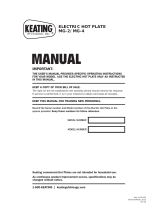 Keating Of Chicago MG-4 Owner's manual
Keating Of Chicago MG-4 Owner's manual
-
Keating Hot Plate Electric Owner's manual
-
Keating MG-4 Operating instructions
-
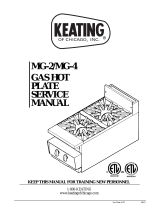 Keating Of Chicago MG-4 User manual
Keating Of Chicago MG-4 User manual
-
Keating 2000 Series Owner's manual
-
Keating SERIES 2000 Owner's manual
-
Keating SERIES 2000 Owner's manual
-
Keating Pre-2000 Series Owner's manual
-
Keating 2009 Operating instructions
Other documents
-
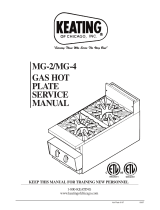 Keating Of Chicago MG-4 User manual
Keating Of Chicago MG-4 User manual
-
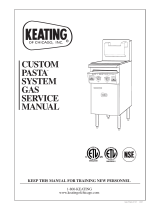 Keating Of Chicago 0107 User manual
Keating Of Chicago 0107 User manual
-
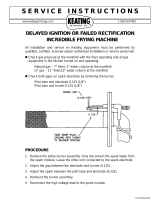 Keating Of Chicago 7/05 User manual
Keating Of Chicago 7/05 User manual
-
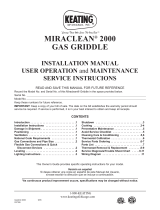 Keating Of Chicago Griddle 2000 User manual
Keating Of Chicago Griddle 2000 User manual
-
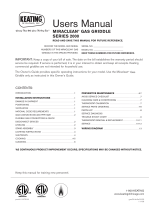 Keating Of Chicago 37399 User manual
Keating Of Chicago 37399 User manual
-
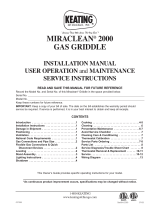 Keating Of Chicago Miraclean User manual
Keating Of Chicago Miraclean User manual
-
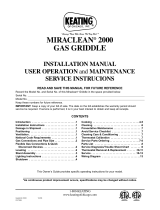 Keating Of Chicago Miraclean User manual
Keating Of Chicago Miraclean User manual
-
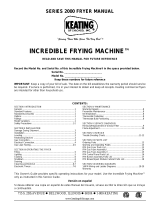 Keating Of Chicago SERIES 2000 User manual
Keating Of Chicago SERIES 2000 User manual
-
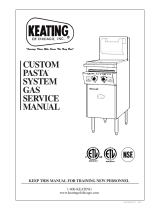 Keating Of Chicago Pasta Maker Gas Custom Pasta System User manual
Keating Of Chicago Pasta Maker Gas Custom Pasta System User manual
-
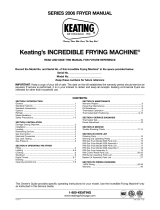 Keating Of Chicago Incredible Frying Machine SERIES 2006 User manual
Keating Of Chicago Incredible Frying Machine SERIES 2006 User manual

























